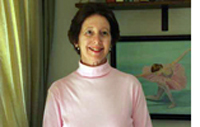| |
|

WEDNESDAY, AUGUST 6-SUNDAY, SEPTEMBER 7

FRIDAY, AUGUST 8


FRIDAY, SEPTEMBER 12, 2008 Temple Solel S'more Shabbat

___________________________________________________________________
MON., SEPT. 29-THURS., OCT. 9


THE VIEW FROM JINSA
Abbas' refusal to accept refugees from Gaza underscores West Bank's separateness
By Shoshana Bryen
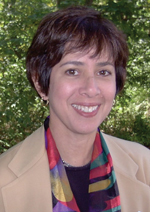 WASHINGTON, D.C--Over the weekend, bloody fighting in Gaza between Hamas and Fatah supporters killed at least 11 people, and 188 Fatah-related Gazans, mainly from the Hilles clan (including 22 injured), fled to the Israel-Gaza border and were rescued by Israel. Israel treated the injured and planned to give everyone safe passage to the West Bank. But Abu Mazen denied them asylum and ordered them returned to Gaza as if they were someone else's people. Hamas arrested the first group returned and Israel has stopped sending them back. They are, for the moment, under detention in Jericho. WASHINGTON, D.C--Over the weekend, bloody fighting in Gaza between Hamas and Fatah supporters killed at least 11 people, and 188 Fatah-related Gazans, mainly from the Hilles clan (including 22 injured), fled to the Israel-Gaza border and were rescued by Israel. Israel treated the injured and planned to give everyone safe passage to the West Bank. But Abu Mazen denied them asylum and ordered them returned to Gaza as if they were someone else's people. Hamas arrested the first group returned and Israel has stopped sending them back. They are, for the moment, under detention in Jericho.
For a variety of legitimate and other reasons, the Palestinians are truly disliked in the Arab world. But it is an irony, or a horror of a different order to find Palestinians expelling Palestinians from what they call "Palestine" and Palestinians in other parts of "Palestine" refusing them entry. It is one thing for other countries to reject them; it is another if they reject themselves - and it has implications beyond the current fighting.
There are ethnic, cultural, familial and tribal differences between Palestinians from the West Bank and those from Gaza. Those on the West Bank had/have strong familial and economic ties to Jordan, and are better settled in towns, cities and villages. A greater percentage is living on land that belongs in their families; fewer live as refugees. West Bankers are more "moderate" (a relative term) and less religious (also relative). When Hamas threw Fatah out of Gaza in 2006, more than 250 Fatah-related Gazans fled to the West Bank. They have not been well integrated and Abu Mazen doesn't want more.
According to The Jerusalem Post, "The (Hilles) clan, which has long been affiliated with Fatah, had a military training base and a number of small factories for manufacturing various types of weapons." So its loyalties to Abu Mazen and Fatah are clear. But it also is said to have had a "mini state" in Gaza, and members were engaged in kidnapping and extortion. They were good enough to fight for Abu Mazen, but not good enough to live next door.
Abu Mazen fears a Hamas takeover on the West Bank - which Israeli intelligence estimates would happen very rapidly if the IDF left the area, and Fatah just fired more than 1,000 police in the West Bank for their Hamas affiliation. But there is also a fear and dislike of Palestinians from Gaza - whether Fatah or Hamas affiliated.
A cautionary word for Americans: American politicians and aspirants for political office routinely support a "two-state solution," meaning Israel and a split Palestinian entity on the West Bank and in Gaza. Some people even propose contiguity for the two parts, running right through Israel. Those who would support such a "solution" should urgently investigate not only the split between Hamas and Fatah, but larger divisions as well. There are now three "states" wedged between the Jordan River and the Mediterranean, any two of which may find themselves at war with each other or the third.
The Administration should revisit its determination to support Palestinian independence both because the Palestinians have been unwilling to meet American conditions for independence, and because prudence requires that the two Palestinian-dominated regions be treated separately. This is a matter of security both for Israel and for Jordan, America's two best allies in the region.



THE JEWISH CITIZEN
New Israel Baseball League president vows to pay its debts and forge a 12-team future
By Donald H. Harrison
 SAN DIEGO—With new financial backing and the promise to pay off its creditors in Israel, the Israel Baseball League is planning a best-of-seven exhibition series at the Baptist Village near Petach Tikvah on August 14 that will match Israeli baseball players against former IBL All-Stars from other parts of the world, according to David Solomont, the league’s new president and major shareholder. SAN DIEGO—With new financial backing and the promise to pay off its creditors in Israel, the Israel Baseball League is planning a best-of-seven exhibition series at the Baptist Village near Petach Tikvah on August 14 that will match Israeli baseball players against former IBL All-Stars from other parts of the world, according to David Solomont, the league’s new president and major shareholder.
Solomont, a Massachusetts-based venture capitalist who describes himself as a big Boston Red Sox fan, said he has been pulling together investors who will pay off the IBL’s outstanding debts while at the same time paving the way for winter ball in Israel’s Negev Desert and the resumption of six-team summer play in 2009.
The American investor said he could have suggested to the previous group of owners of the Israel Baseball League that they simply declare bankruptcy and then he could have started a new league fresh. However, he said, he felt the right thing to do was to pay off the debts that were accumulated by the group headed by Larry Baras.
Originally the IBL capitalized with one million dollars, which Solomont said was insufficient given all the baseball infrastructure that needed to be developed in Israel, unexpected expenditures on a variety of items including such government fees as the Value Added Tax, and the slippage of the dollar against the Israeli shekel.
Solomont praised Baras as a visionary, who like those involved in manykinds of start-up enterprises, had inufficient inforrmation about the real costs. He said $2 million in capitalization would have been more prudent and would have avoided some of the problems that the League now faces in paying off creditors. As a new owner, he said, he believes he must exercise “due diligence” in examining claims made by creditors, some of which are questionable, he said.
At the same time, he said in a telephone interview, to bring in new investment into the League, he cannot solely pay off old debts, but also must begin spending money to assure future programming and revenues.
Among Israel Baseball League’s creditors is the agricultural school at Kfar Hayarok (“The Green Village”), to the north of Tel Aviv, where in the summer of 2007, approximately 100 players and coaches, representing all six teams of the IBL, were lodged.
As San Diego Jewish World had extensively covered the IBL in 2007 (using daily summaries as well as feature stories by our correspondent, Dr. Yoni Peres, whose veterinary practice is associated with the school), we were contacted by Kobi Naveh, the chief executive officer of the school, where 1,200 students live and attend classes except in the summer.
Naveh wrote the following letter (which we have edited for translation errors) to San Diego Jewish World last month:
“On June 2007, Israel Baseball League’s representatives had visited us in order to examine an option for accommodating a group of professional American baseball teams in Hakfar Hayarok. The initiative came from Larry Baras. Last year, the first baseball tournament was held in Israel.
“After visiting the place, Larry Baras agreed that 100 baseball players would be hosted (including full accommodation) in Hakfar Hayarok’s dormitories.
“During July-August 2007, the games were held in different places in the country and received a lot of publicity in the media and a lot has been written about the establishment of Israel’s baseball league and the continuation of the games in summer 2008.
“At the end of the hosting period, Larry Baras met us at Hakfar Hayarok’s management office. He informed us that some of the League investors’ money had not reached him and therefore he was returning to the U.S. to raise the money as promised. He left us a cheque for the remaining debt dated September 9, 2007.
“A few days before the payment date, we were informed that there was still no money in the league’s account and we were told to wait until we received a confirmation from Larry to deposit the cheque.
“The debt that has been left is more than $170,000. We have held talks with Larry and have been corresponding via email but the debt has not been paid yet.
“Hakfar Hayarok hosts groups during the summer in the dormitories in order to raise funds for the students in the dormitories. The children living in Hakfar Hayarok are from age 5 to 18 and come from impoverished and low social-economic backgrounds. The money we are trying to raise for them is critically important for their wellbeing and education. The fact that this debt has not been paid already caused great damage to these children.
“We will be deeply grateful for any help in this matter.”
The letter prompted us at San Diego Jewish World to send-off emails to two different addresses to Larry Baras. He responded that he would be back in touch with us this week. However, the telephone call that came on Tuesday, August 5, was from Solomont, the new owner, who said that Baras now is out of the picture.
Solomont said that he has been putting a new management team in place. Dan Duquette, who had served in general manager positions for both the Boston Red Sox and for the Montreal Expos, was named the IBL’s head of baseball operations, and sports promoter and venture capitalist Gary Woolf was named as an IBL director. Another key appointment was of attorney Martin Berger, who will look after the IBL’s interests in the United States. Director of Israel operations is Ami Baran, an Israeli track and field star, in the javelin event, who has coached Israeli teams both in track and in softball.
Solomont said that he had not yet sent any money to Hakfar Hayarok but planned to make a good faith payment of $10,000 U.S. this week or next, and would subsequently seek a meeting with the school’s director on his next trip to Israel.
“Hakfar Hayarok will get taken care of, per what they believe they are owed,” Solomont told San Diego Jewish World. He said payment to the school might have been quicker but for two glitches that were not the school’s fault. The first was that the paperwork left to him didn’t reflect requested additional services that the IBL received after the contract was signed. Secondly, he said, he at first had difficulty reconciling the numbers because he had been doing the calculations in dollars, while the contract called for payment in shekalim. The Israeli currency has been growing stronger against the U.S. dollar in the last year.
Solomont said he similarly will review invoices submitted by other creditors, and will work his way through those debts.
“All these organizations ought to be rallying behind the IBL to see what we can all do to make it a success,” he said.
He said in its infant 2007 season, IBL brought 1,000 visitors to Israel, who pumped money into the economy. The League also was a factor in a decision by the Jewish National Fund to build more baseball fields around the country, he said.
The teams in 2007 bore such names as the Bet Shemesh Blue Sox, the Modi’in Miracle, the Ra’anana Express, Netanya Tigers, Petach Tikvah Pioneers and the Tel Aviv Lightning.
They took turns as home teams at three fields all in the greater Tel Aviv area. One was at Baptist Village near the Yarkon River, another was at Kibbutz Gezer, and the third was at the Sportek facility in Tel Aviv.
“Next year in Jerusalem,” said Solomont, explaining that one of the team’s names will be changed in Summer 2009 to—what else?— “Jerusalem Gold.”
He said the league plans to sell at least two of the six team franchises initially, and after this process is implemented and refined, to sell the others. He said he hopes that eventually there will be 12 teams in the Israel Baseball League.
As for winter baseball in the Negev, Solomont said there is no better location for it, given the large number of flights both from Asia and Europe directly to Israel. From the standpoint of winter baseball, said Solomont, Israel could become the “Dominican Republic of the Middle East.”

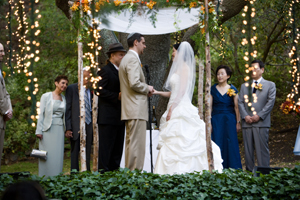 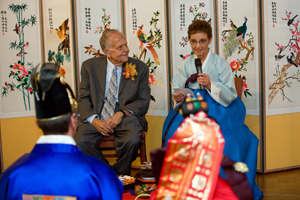
)
Jewish-Korean wedding provides blend of two cultures with two distinct ceremonies
By Eileen Wingard
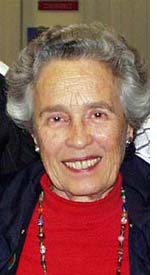 MALIBU, California—The statistics confirm that more than 50% of our Jewish American young adults are selecting non-Jewish spouses. What form do their weddings take? Each one is unique and depends on the level of cultural and religious content the couple wishes to include.. MALIBU, California—The statistics confirm that more than 50% of our Jewish American young adults are selecting non-Jewish spouses. What form do their weddings take? Each one is unique and depends on the level of cultural and religious content the couple wishes to include..
My husband and I recently attended one such matrimonial event at the Calamigos Ranch in Malibu, California where my cousin, Dr. Ben Gilmore, married Sujin Yoon, a native of Korea. Both a Jewish ceremony and a Korean Tea Ceremony were part of their wedding rituals.
Rabbi Mordecai Finley, one of the most respected and creative rabbis of Southern California, officiated at the Jewish ceremony. Two decades earlier, he had presided at Ben’s Bar Mitzvah and the rabbi remembered the groom as one of his brightest and most questioning students. With a chuppah, the reading of the Ketubah, the Shiva Brachot, the breaking of the glass, the ceremony felt traditionally Jewish. Only the reading of a passage on love from Corithians hinted at Sujin’s Christian background.
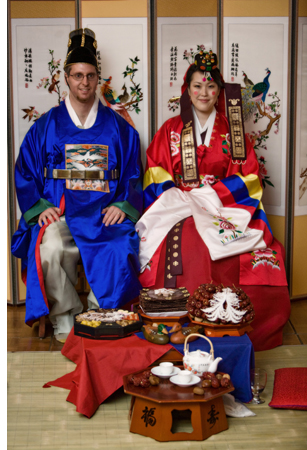 Following the Jewish ceremony, held in a clearing among giant oak trees, the guests moved to a pavilion for cocktails and hors d’oevres before assembling to witness the Korean ceremony. During that time, the bride exchanged her white bridal gown for an elaborate attire with intricate headdress and the groom traded his grey suit for a colorful silken outfit with peaked hat, both imitating the garb of Korean royalty. Ben and Sujin’s mothers also changed into billowing long dresses of fine brocaded silk. First Ben’s parents sat in the place of honor and Ben and Sujin brought gifts from Sujin’s parents to the Gilmores. Each gift had its unique symbolism. Sujin’s sister narrated, explaining Following the Jewish ceremony, held in a clearing among giant oak trees, the guests moved to a pavilion for cocktails and hors d’oevres before assembling to witness the Korean ceremony. During that time, the bride exchanged her white bridal gown for an elaborate attire with intricate headdress and the groom traded his grey suit for a colorful silken outfit with peaked hat, both imitating the garb of Korean royalty. Ben and Sujin’s mothers also changed into billowing long dresses of fine brocaded silk. First Ben’s parents sat in the place of honor and Ben and Sujin brought gifts from Sujin’s parents to the Gilmores. Each gift had its unique symbolism. Sujin’s sister narrated, explaining
what each item represented. On pillows set before them, Ben and Sujin kneeled and bowed before his parents. The parents tossed dried fruit and chestnuts at the newlyweds, symbolic of fertility wishes.
Next, Ben’s parents each offered words of wisdom to the bride and groom. The same sequence was followed with the bride's parents sitting in the place of honor.
"I became much more familiar with my Korean heritage through this marriage," commented Sujin. Her parents had not included the 300 year old Tea Ceremony in their own wedding, but Sujin elected to have that as part of her nuptuals.
"I learned more about my Jewish heritage marrying Sujin than I would have by marrying a Jewish woman," observed Ben, "because I needed to know our traditions to be able to explain them to her."
The great respect and love of ancestors which both cultures share was illustrated by a miniature tree on which was hung photos of the couple’s deceased elders. I recognized the picture of my great-grandmother, Chaya Rochel Uretzky, displayed along with Sujin’s forebearers.
A feeling of warmth and love permeated the wedding as both families reached out to eachother. All joined in a spirited hora, and when Sujin’s sister concluded a toast describing her younger sibling, she lifted her glass with inter-religious fervor and proclaimed: "l’chaim!"
After the cake cutting, the groom expressed thanks to his parents in English, Sujin presented her remarks to her parents in Korean, then translated her words into English.
I couldn't help wondering how my Uncle Peter would have reacted had he been alive to witness his grandson Ben’s wedding. He felt very strongly about the Jewish people and Jewish continuity. Peter, my mother’s younger brother, was one of eight children who all experienced the ravages of pogroms. Six of them and their parents managed to escape; five immigrating to the United States, one to Canada. Those six were all staunch supporters of Israel and treasured their Jewish legacy.
Yet, my Uncle Peter was a welcoming, loving person. And family always came first. He was not a Tevya-type who would ever reject any of his children or grandchildren. If he had lived to see the love in Ben’s eyes, and met the bright and vivacious Sujin, I think he would have given the bridal
couple his blessings.

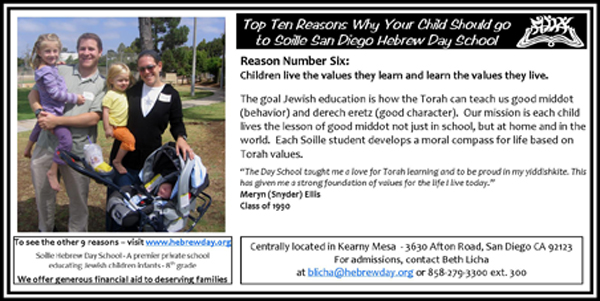


GUEST COLUMN
Jews are also the 'people of the comic book'
By Joseph F. Laredo
 SAN DIEGO—If the saturation media coverage of the San Diego Comic Con International this year wasn’t enough to drive home the event’s magnitude and scope, this observer and attendee would like to assure you that these once humble festivities have evolved into a pop cultural bacchanalia to be reckoned with. Final attendance figures for this year’s Con, which began with a special preview night on Wednesday, July 23, and continued through Sunday, July 29, have yet to be made public, but they are almost certain to surpass last year’s record-setting influx of 125,000 participants. SAN DIEGO—If the saturation media coverage of the San Diego Comic Con International this year wasn’t enough to drive home the event’s magnitude and scope, this observer and attendee would like to assure you that these once humble festivities have evolved into a pop cultural bacchanalia to be reckoned with. Final attendance figures for this year’s Con, which began with a special preview night on Wednesday, July 23, and continued through Sunday, July 29, have yet to be made public, but they are almost certain to surpass last year’s record-setting influx of 125,000 participants.
In 2008, for the first time in the Con’s 39-year history, tickets for all four main days of activity were sold out well in advance, leading some to speculate whether San Diego will continue to remain home to an annual celebration that had its start when roughly 300 comic book enthusiasts gathered in the basement of the U.S. Grant Hotel in 1970. In the intervening decades, the Con’s agenda has broadened to embrace such diverse pop cultural elements as animation, video games, collectible toys, and the heady realms of television and feature films (Hollywood studios with upcoming releases to plug have very nearly displaced comics publishers as the focus of attention).
Comic Con has evolved into the largest event of its kind in the world. Although the Con is committed to remain based at the San Diego Convention Center until 2012, there are continual rumors that Anaheim, Los Angeles, and Las Vegas are all intent upon wooing it away should they have an opportunity.
Despite the almost bewildering array of options that the Con currently presents visitors, its public relations director David Glanzer insists that, at least in spirit, the event remains in many ways “exactly the same as when it began.” John Rogers, the President of the Con’s Board of Directors, explains that, “It is our dedication to comic books as art form and an important part of American culture that drives us all.” It would be difficult to overestimate the seminal contributions of Jewish creative talent to this unique medium over the years. Although Jewish creators like Jerry Siegel & Joe Shuster; Bob Kane, and Stan Lee are not exactly hallowed names outside the realm of comics cognoscenti, their respective creations of Superman; Batman, and Spider-Man provided comic books with their defining and most universally-beloved icons.
“Jews built the comic book industry from the ground up,” asserts “Mad” magazine writer Arie Kaplan, ”and the influence of Jewish writers, artists, and editors continues to be felt to this day.” One of the most important of these pioneers was Will Eisner, whose crime-fighting creation The Spirit is slated to make his film debut this December (director and comics creator Frank Miller visited this year’s Con with a preview). His nearly seventy-year career was so influential that the Will Eisner Comic Industry Awards has become an annual highlight of Comic Con, and an Eisner Award carries with it the same level of respect and prestige in the comics arena that an Oscar commands in the film community.
One of Will Eisner’s most important contributions was a 1978 work entitled A Contract With God. It used the sequential art presentation style of comic books to explore mature and complex themes. Eisner characterized the finished result as a “graphic novel,” and the enthusiastic critical and commercial reception accorded the book helped usher that term into common parlance and essentially gave birth to one of the most vibrant genres in the comics industry. Art Spiegelman, an important figure in the “underground” or counterculture comics of the ‘60s, brilliantly pushed the boundaries of the graphic novel with Maus: A Survivor’s Tale, an anthropomorphic recounting of the Holocaust and its impact on his family that was recognized by a special Pulitzer Prize citation in 1992.
At this year’s 20th annual Eisner Awards, the award for Best New Graphic Novel was given to Tel-Aviv-born creator Rutu Modan for her first solo graphic novel Exit Wounds, published in the U.S. by Drawn & Quarterly. Modan uses the aftermath of a suicide bombing as the vehicle for a complex, multi-layered exploration of life in contemporary Israel. Like Eisner and Spiegelman before her, Modan’s work carries with it the implicit argument that comics can rise to the heights of great literature. The limitless possibilities of the modern graphic novel are a potent rebuttal to those misguided souls who cling to the belief that the province of comics extends no farther than funny animals and costumed crusaders.
Will Eisner, a fixture at Comic Con until his death in 2005, was posthumously honored at this year’s event by a special screening of the documentary tribute Will Eisner: Portrait of a Sequential Artist, a Montilla Pictures release that made its debut in 2007 at the prestigious Tribeca Film Festival. In the publishing world, the continuing influence of Eisner, his contemporaries, and those who followed in their footsteps has yielded a bumper crop of intriguing titles in recent years. The most noteworthy success has been Michael Chabon’s The Amazing Adventures of Kavalier & Clay, a novel exploring the early days of comics that received a Pulitzer Prize for fiction in 2001.
Last year, Disguised as Clark Kent: Jews, Comics, and the Creation of the Superhero by Danny Fingeroth raised a few eyebrows by drawing parallels between the stories of Superman and Moses and contrasting morality-tales from Spider-Man comics with the Torah. Comics writer Arie Kaplan interviewed Will Eisner, Stan Lee, Jack Kirby and other legendary figures for a historical survey, From Krakow to Krypton: Jews and Comic Books, that is due out in paperback this September. The latest entry in this steady stream of scholarship is Jews and American Comics, a forthcoming release from New Press edited by Paul Buhle that made a pre-publication debut at this year’s Comic Con. Its publicity material promises a comprehensive explanation of “how the ‘people of the book’ became the people of the comic book.”
The organizers of Comic Con have always had a soft spot for anniversaries, and included among the significant milestones celebrated this year were the 75th Anniversaries of pulp magazine adventure hero Doc Savage; simian cinema superstar King Kong, and the American comic book industry itself (based on the widely accepted assumption that it was born with the publication of a magazine containing reprints of newspaper comic strips entitled “Funnies on Parade” in the spring of 1933).
These observances were guaranteed to gladden the hearts of traditionalists, but there were many other hugely popular events at the Con, such as panels devoted to televised situation comedies and a myriad of forthcoming science fiction extravaganzas, with a connection to comic books that was tangential at best. Some comic book dealers grumbled audibly about the rising fees charged for booths in the convention center’s mammoth exhibition hall, and rued the fact that their wares were being shunted off center stage by elaborate displays and pavilions hosted by seemingly every major studio in Hollywood. Of course, these were precisely the magnets that pulled in so many of this year’s attendees.
The Comic Con has become such a sprawling array of opportunities that, much like a massive assembly of over-stimulated snowflakes, no two visitors are likely to have an identical experience. Many simply can’t get enough. As I was leaving the Convention Center on Sunday, I witnessed one true believer gaze back wistfully over his shoulder and shout, “Only 360 days until Comic Con 2009!”


ADVENTURES IN SAN DIEGO JEWISH HISTORY
Editor's Note: To create a permanent and accessible archive, we are reprinting news articles that appeared in back issues of various San Diego Jewish newspapers. You may access an index of the headlines of those articles by clicking here. You may also use the Google search program on our home page or on the headline index page to search for keywords or names.
San Diego B’nai B’rith Women
From Southwestern Jewish Press, October 1949, page 6
At the last meeting held by the San Diego B’nai B’rith Women two weeks ago, the main order of business was election of officers for the coming year.
Elected to guide this new organization for the next twelve months are the following ladies: President, Mrs. Harold Garvin; 1st vice-president, Mrs. David Schloss; 2nd vice-president; Mrs. Sidney Rose; corresponding secretary, Mrs. Victor Weiss; recording secretary, Mrs. Stanley Yukon, and treasurer, Mrs. Rose Sloane.
Trustees are Mesdames E. Max Cohen, Rose Abrams and Eva Berger. The posts of Sentinel and Guard are held by Mrs. Jennie Turner ad Mrs. Dorothy Deutch. Counselor is Mrs. Herman Tulchinksy.
The presentation of a Charter and installation of these new officers will be held in the near future.
At the next meeting, which will be held Monday evening, October 10 at 8:00 p.m., in Tifereth Israel, committee chairmen, will be appointed.
Council to Celebrate National Council Day
From Southwestern Jewish Press, October 1949, page 6
The San Diego Section of the National Council of Jewish Women will celebrate National Council Day on Saturday, October 15th.
The big event of the Day will be the formal house-warming of the new Council House at 3138 Grape Street. Opened just one month ago, the Council House now has fourteen new émigrés, including two beautiful young children.
The San Diego Section of the National Council of Jewish Women extends a cordial invitation to the entire Jewish community to help them celebrate National Council Day by attending the Housewarming. The new people are anxious to meet the community and Council is anxious for the community to meet the new people.
Mark your calendar and be sure to attend the Council House warming, Saturday, October 15th, at 2:00 p.m. at 3138 Grape Street.
Ladies Auxiliary J.W. V. Post No. 185
From Southwestern Jewish Press, October 1949, page 6
The Ladies Auxiliary to J.W. V. Post No. 185 has completed its plans for a Dinner and card Party which they will hold on Sunday, November 20th in Temple Center, 3rd and Laurel Street.
Proceeds of this affair, for which Pauline Rubel is chairman with Esther Levittt as co-chairman, will be used for the Hospital work done by the group.
A new project undertaken by the Ladies Auxiliary will be the taking of at least 25 hospitalized veterans from Naval Hospital to the football games each week. All costs will be absorbed by the group.
Tifereth Israel Sisterhood
From Southwestern Jewish Press, October 1949, page 6
At the meeting held Thursday, October 6th by the Tifereth Israel Sisterhood, Mrs. Lou Moorsteen was the guest speaker. She spoke and showed colored film taken on her recent trip to Israel.
Hostesses who served traditional Succoth refreshments were Mesdames Herman Tulchinsky, William Solof, Joe Spatz, Jack Sonnabaum, Abe Ratner, Nate Ratner and Louis Steinman.,
A report was given at the meeting of the “Quiz Tea” held recently at Radio Station KCBQ which was highly successful in every way. Mrs. Sidney Newman, president, presided.

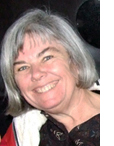 Nancy Harrison Nancy Harrison
cruise & tour specialist
(619) 265-0808



SAN DIEGO JEWISH WORLD THE WEEK IN REVIEW
Sports/ 2008 JCC Maccabi Games
'Why Volleyball?' nets many responses by Danielle Potiker and Daniela Federman in San Diego
U.S. Jewish athletes ready for Beijing Olympics in four different sports by "SD Pipeline" staff in San Diego
San Diego
Father transforms his grief into helping thousands in the name of his daughter by Donald H. Harrison in San Diego
Arts
The Receptionist will soon lure you into office comedy/drama at Cygnet Theatre by Carol Davis in San Diego
Pen: A writing implement, or a prison? by Cynthia Citron in Beverly Hills, California
Lifestyles
Two Jewish women win acclaim for their restaurants: Lehn Goetz and Tracy Borkum by Lynne Thrope in San Diego
Adventures in San Diego Jewish History
—October 1949: J.C.R.A
—October 1949: Jolly 16 Celebrates 35 Years of Service
—October 1949:Senior Pioneer Women
—October 1949: Birdie Stodel Chapter No. 92 B’nai B’rith
by Ulla Hadar in Kibbutz Ruhama, Israel by Joel A. Moskowitz, M.D. by Sheila Orysiek in San DiegoOctober 1949:October 1949:October 1949October 1949:
InternationalBush hopes to salvage Mideast success unrealistic with decline in Olmert's power by Ira Sharkansky in Jerusalem
Decisions continue with or without Olmert by Shoshana Bryen in Washington, D.C.
Judaism
Leaving matters on a positive note by Rabbi Leonard Rosenthal in San Diego
Sports
JCC Maccabi Games: Co-ed flag footballers are "two-a-dayers" by Gary Rotto in San Diego
A bissel sports trivia with Bruce Lowitt in Clearwater, Florida
Arts
Lombrozo's 'Air Filter' reflects skyline, role of 'urban tree' as waterfront show launched by Donald H. Harrison in San Diego
Adventures in San Diego Jewish History
—October 1949: Kaufman Appointed New Managing Editor Of The Jewish Press
—October 1949: Notice {Publication Date Change}
—October 1949:New Federation Plans Survey
—October 1949: Editorial Page… Policy
—October 1949: Overseas News and Views by Maxwell Kaufman
Environment
Abramson is helping to preserve the earth one diatom and polar bear at a time by Donald H. Harrison in San Diego
Arts
Yank! A New Musical explores the travails of gays in the military during WWII by Carol Davis in San Diego
Assassins:Creepy subject, yet good musical by Cynthia Citron in Hollywood
Chapter 19 of Reluctant Martyr, a serialized novel by Sheila Orysiek
Sports
Backroom hums as Maccabi Games near by Gary Rotto in La Jolla, California
Adventures in San Diego Jewish History
—September 1949: San Diego Lasker Lodge B’nai B’rith News by Morrie Kraus
—September 1949: Samuel I. Fox Lodge No. 1747, B’nai B’rith
—September 1949: Kaufmans Return From Two Year European JDC Work
—September 1949: Esther Weitzman Given Signal Honor
International
Peace negotiations produce little news by Ira Sharkansky in Jerusalem
Temple Solel travelers inspect soldiers' quarters as part of 'Project Kibbutz' by Ulla Hadar in Kibbutz Ruhama, Israel
National
How kosher was the U-T's meat coverage? by Gary Rotto in San Diego
Arts
Thursdays with The Songs of Hal Wingard
—#37, Growing Old
—#293, As People Grow Old
—#303, Home for the Aged
A literary giant emerges from self-exile by David Strom in San Diego
Basic Jewish concepts to our children—and perhaps to Chinese workers too by Donald H. Harrison in San Diego
Adventures in San Diego Jewish History
—September 1949: Make Fall Plans For Community Center
—September 1949: Closing Program Climaxes Day Camp
—September 1949: Jacobson to Be Honored at N.Y. Presentation
—September 1949: Men’s Club of Temple Beth Israel Holds Election of Officers
International
Average Americans more resolute than Congress in responding to gasoline crisis by Shoshana Bryen in Washington, D.C.
Amid such beauty, once was such horror by Ulla Hadar in Meina, Italy
Germans paying compensation to survivors who worked in ghettos run by the Nazis by Donald H. Harrison in La Jolla, California
The Jews Down Under, a roundup of news in the Southern Hemisphere by Garry Fabian:
—Jewish delegation greets Pope Benedict XVI in Australia during World Youth Day fete
—Warm feelings flow from World Youth Day
—Pope entertained by Jewish singers
—Community move against bogus collectors
—Educator honoured by former teacher
—Early immigration records now on line
—National Rabbinic Conference held
—Youth Movements Unite in South Australia
—The Jewish and Kosher Community of Fiji (News from 'halfway down under')
Sports
San Diego teen athletes ready to host and to compete in JCC Maccabi games next week by Gary Rotto in San Diego
Adventures in San Diego Jewish History
—August 1949: Nu by Red Borscht
—August 1949: Beta Tau
—August 1949:Hear About Brandeis by Sid Stokes
—August 1949: Solomon Attends Youth Conference
|
|
